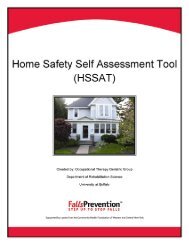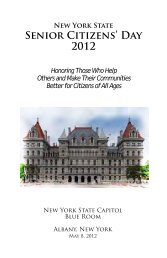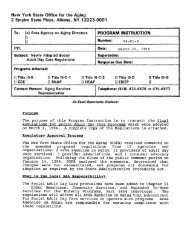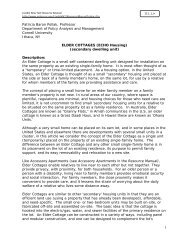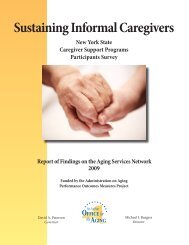White Paper - New York State Office for the Aging
White Paper - New York State Office for the Aging
White Paper - New York State Office for the Aging
- No tags were found...
Create successful ePaper yourself
Turn your PDF publications into a flip-book with our unique Google optimized e-Paper software.
INTRODUCTION<br />
Following publication of <strong>the</strong> two documents, <strong>the</strong> <strong>State</strong> <strong>Office</strong> <strong>for</strong> <strong>the</strong> <strong>Aging</strong> and<br />
<strong>the</strong> <strong>State</strong> Society on <strong>Aging</strong> held Community Forums across <strong>the</strong> state to discuss <strong>the</strong> topics<br />
presented in <strong>the</strong> Project 2015 articles and briefs.<br />
Very few states have endeavored to accomplish a planning project similar to<br />
<strong>the</strong> one that <strong>New</strong> <strong>York</strong> <strong>State</strong> has undertaken. Examples include North Carolina and<br />
Minnesota; both have reviewed <strong>the</strong> projections of an older population, and <strong>the</strong> <strong>State</strong><br />
of Minnesota has undertaken some major changes in <strong>the</strong> provision of long term care<br />
as a result of its predicted number of older people. Nei<strong>the</strong>r state has <strong>the</strong> double<br />
impact of both an older population and a more culturally diverse population of all<br />
ages. Cali<strong>for</strong>nia has developed a Strategic Planning Initiative <strong>for</strong> Older Cali<strong>for</strong>nians,<br />
and it used <strong>New</strong> <strong>York</strong> <strong>State</strong> as part of its model. In 1999, <strong>the</strong> United Nations hosted<br />
an International Year of Older Persons, which focused international attention on an<br />
increasing older population in industrialized nations worldwide. As part of this yearlong<br />
focus, events held in <strong>New</strong> <strong>York</strong> City and Washington, D.C. promoted <strong>the</strong><br />
economic and cultural value of older people to society. In April 2002, <strong>the</strong> United<br />
Nations hosted <strong>the</strong> Second World Assembly on <strong>Aging</strong> in Madrid in order to discuss<br />
and adopt an International Plan of Action on <strong>Aging</strong>. The Plan calls <strong>for</strong> changes in<br />
attitudes, in national and international policies, and in community, corporate and<br />
organizational practices so that <strong>the</strong> enormous potential of aging in <strong>the</strong> 21 st century is<br />
fulfilled. The Plan seeks to ensure that people everywhere will be enabled to age with<br />
security and dignity, and continue to participate in <strong>the</strong>ir societies as citizens with full<br />
rights.<br />
Current Activities<br />
In February 2002, Governor George E. Pataki charged 36 cabinet-level state<br />
government agencies to review <strong>the</strong>ir major policies, programs, and structure in light of<br />
<strong>the</strong> <strong>State</strong>’s increasingly older and more diverse population, particularly <strong>the</strong> aging of <strong>the</strong><br />
Baby Boomer generation into <strong>the</strong> elder cohort. The Governor’s Director of Operations,<br />
James Natoli, likened <strong>the</strong> <strong>for</strong>thcoming Elder Boom to that of <strong>the</strong> Baby Boom when <strong>the</strong>y<br />
were to begin school in <strong>the</strong> 1950s. Major plans <strong>for</strong> consolidation and expansion were put<br />
in place <strong>for</strong> <strong>the</strong>m at that time. It is now time to prepare <strong>for</strong> <strong>the</strong>ir old age. The Governor<br />
titled this initiative “Project 2015: <strong>State</strong> Agencies Prepare <strong>for</strong> <strong>the</strong> Impact of an <strong>Aging</strong><br />
<strong>New</strong> <strong>York</strong>.”<br />
During 2002, <strong>the</strong> 36 state agencies, led by <strong>the</strong> <strong>State</strong> <strong>Office</strong> <strong>for</strong> <strong>the</strong> <strong>Aging</strong>,<br />
established a workgroup with representation from senior staff of <strong>the</strong> agencies. The<br />
Governor’s <strong>Office</strong> of Employee Relations provided valuable assistance in facilitation and<br />
workgroup and meeting organization, and <strong>the</strong> Empire <strong>State</strong> Development <strong>State</strong> Data<br />
Center contributed significant demographic data to assist <strong>the</strong> agencies in <strong>the</strong>ir<br />
deliberations and planning. The state agencies reviewed <strong>the</strong>ir major programs, policies,<br />
and procedures and each developed a policy brief that highlighted critical functions or<br />
issue areas that would be affected by <strong>the</strong> <strong>State</strong>’s shifting demographic profile and which<br />
should be addressed within <strong>the</strong> next ten years. Through a prioritization process, each<br />
2



